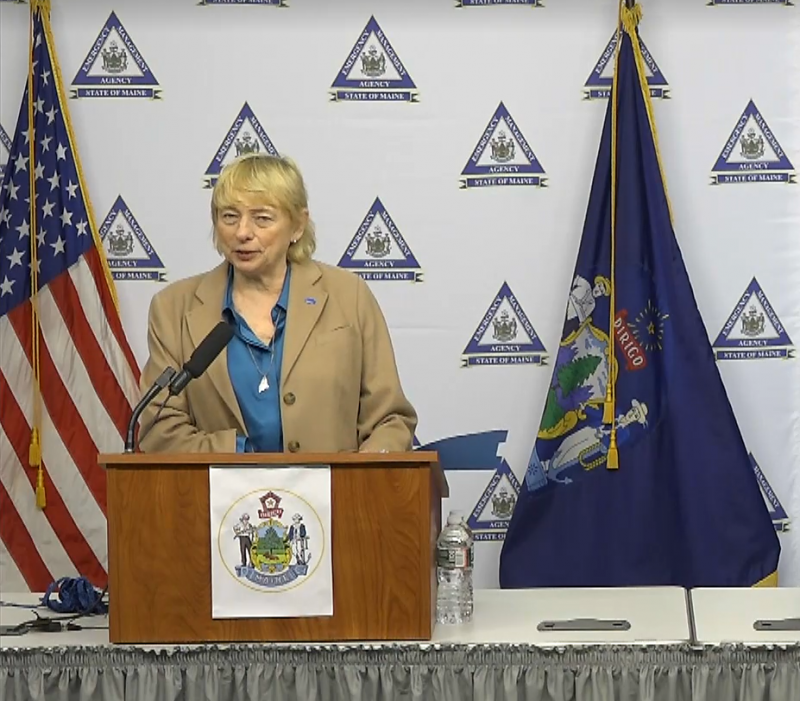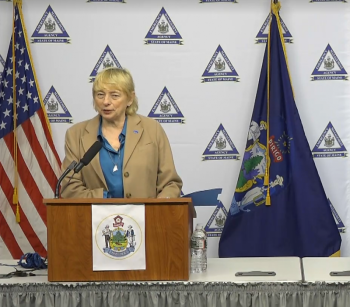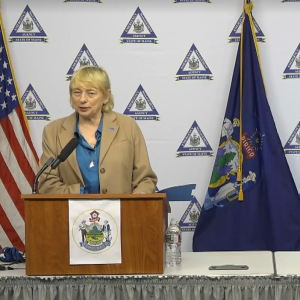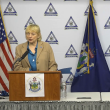Gov. Mills discusses opioids in weekly address
This week’s radio address features Governor Mills’ remarks as delivered during her July 23 Second Annual Opioid Response Summit,“Compassion, Community, Connection.”
Greetings. It’s good to see all of you, though I cannot see you up close. It’s good to hear you, though I cannot discern your voices. But you are here in every real way. And the most powerful voices of people in recovery are being heard around the state and around the world.
When I was in Fifth grade in Gorham elementary school I read comic books every day after school (sometimes during school) — mostly male superheroes like Spider Man, Iron Man and Super Man.
Super Man, although he came to live and perform his super hero work in the metropolis, you will remember, actually retreated to a mountain sanctuary in some frozen tundra in the Arctic, a home his creators called the “Fortress of Solitude,” a place of solace and a sometime solitary headquarters for the “Man of Steel,” a place adorned with sentimental memorials to his long lost Kryptonian parents, Jor-El and Lara, and located in a polar wasteland not found on any destination vacation map.
In the past four months especially, many of us have retreated to our own “Fortress of Solitude,” where we have hibernated, closeted ourselves, physically, mentally and emotionally, in a cave of safety and isolation where we have been compelled to escape an unprecedented threat to the health and safety of our state, our country, and our world.
On March 15th, I issued an Executive Order directing all Maine people to “stay at home.” And Maine people did.
Those who stayed at home were working families, elderly grandparents, single moms and dads, state employees, factory workers, builders and teachers; but there were some who were without homes. And there were some with no families with whom to seek such sanctuary. And there were good people who had come to rely on friends, therapists, programs and groups to support them in kicking long term habits and dependencies who could not rely on those relationships in the same ways any more.
Suddenly support groups could not meet. Suddenly medication assisted therapy sometimes became out of reach. Suddenly some who usually answered a call were no longer there.
People with substance abuse disorders fell through the cracks.
People with mental health challenges fell through the cracks.
People with both mental health and substance abuse disorders fell hard.
Many found themselves alone in their own “fortress of solitude.”
I want to say today, “We have not forgotten you.” Come down from your tower, come out of your fortress. Because you are not alone.
Solitude consumed many of us. Aloneness became loneliness, personal connectivity deserted us.
We have found in this time of national insecurity, a time of unrelenting fear for our personal health and public and communal safety, that our material ambitions in life perhaps are hollow, that our financial and professional goals in truth are secondary to personal health, and that family and community cohesiveness is found not solely in Saturday night suppers or Beano games or church services and meetings, parades, festivals, bars and dances, but in the telephone call from one single person in need of a friendly voice; the email from a long lost classmate or cousin; the letter from someone you’d barely met but liked, a friendly photo on Instagram or Snap Chat.
The term “outreach” has suddenly taken on all new meaning.
People have reached out during this pandemic. And we have re-discovered our own humanity and our shared purpose in life.
Not entirely, of course. We have also lost many souls, as the parallel pandemic of substance use disorder has stolen the lives, livelihoods and sense of purpose of hundreds who swallowed pills, stuck needles in their arms and gave up on the rest of us who just couldn’t be there to help.
Their fortress of solitude crumbled. Some were simply out of reach.
And yet, heroes and helpers did come forth. Many of you listening to me this morning turned to, adapted, and saved lives. You turned your own anxiety into action, outpacing the feeling of helplessness that overcame others.
Outpatient treatment programs (methadone clinics) pivoted to providing take home doses to avoid daily trips to the clinic. The number of take home doses per weekly doubled to over 18,000 for over 3300 patients; and this change does not appear to have resulted in a single death.
Though the 13 recovery centers in Maine closed to drop-in traffic four months ago, volunteer recovery coaches worked throughout the period, calling persons in recovery and checking in on their wellbeing.
Downeast Treatment Center in Ellsworth, which operates an Opioid Health Home, experienced an increase in referrals during the pandemic because they quickly launched telehealth visits. People who previously had to drive long distances for treatment now started treatment immediately with a phone call; they had prescriptions emailed to their local pharmacy and got connected with a counselor for a virtual visit within a week. With transportation across the state such a challenge, the ability to quickly move to telehealth has increased access to much needed treatment, especially in rural areas.
Within days of the closure, dozens of support meetings such as AA transitioned to virtual platforms, allowing individuals to participate without having to arrange transportation or child care, etc.
Recovery residences opened their doors in Millinocket (for women) and Caribou (for men). There are now 114 recovery residences in the state, 41 of them being nationally certified. We are supporting 16 of these homes through a pilot program through Maine Housing with funds from the Office of Behavioral Health.
Robust Narcan distribution continued over these past four months, with an additional 20,000 doses purchased with state funds in the spring. Syringe exchange programs expanded during the same period, and we made adjustments to protect exchange members and allow for social distancing during the pandemic (Exec. Order 27).
Fred Rogers — Mr. Rogers — said, “When I was a boy and I would see scary things in the news, my mother would say to me, "Look for the helpers. You will always find people who are helping.”
Many of you listening to me today are the helpers, and your efforts over the past few months have been nothing short of heroic. It was only a year and a half ago, though it seems like the distant past now, that I took the oath of office of Governor.
The very next day, I signed Executive Order Number One which expanded MaineCare. Little did we know that just over fourteen months after that, tens of thousands of people in Maine who became unexpectedly unemployed or suddenly underemployed would rely on this program for lifesaving healthcare, including mental health and substance use disorder treatment.
Virtually my second act in office was to announce a comprehensive response to the epidemic of substance use disorder in our state, something I had prioritized and fought for previously as Attorney General.
First, I appointed Gordon Smith as Maine’s very first Director of Opioid Response. Gordon, with nearly forty years experience with the Maine Medical Association, and his reputation inside and outside the state house as a dogged researcher, an able advocate and a person of great integrity, became our Administration’s eyes and ears on the ground, looking at what works and what might not work, finding critical funding for new services, talking with people all over the state, and standing up programs in regions where virtually no help existed before.
Shortly after that I issued Executive Order Number Two, which committed state government to a series of actions to address the substance use crisis, including:
- Purchasing and distributing thousands of doses of the life-saving drug Naloxone
- Supporting low barrier access to Suboxone (Buprenorphine) in all 33 emergency departments in the state.
- Providing medication assisted treatment in all Department of Corrections prison facilities and in all county jails, and
- Recruiting, training and coordinating 250 recovery coaches to provide emergency support to those in crisis.
We stipulated that these actions would all be carried out in a manner designed to decrease the stigma attached to substance use disorder, reminding people that this illness is a chronic disease and should be treated as such.
Since that time, the state has purchased 35,000 doses of Naloxone. Medication assisted treatment is now available in two-thirds of our hospital emergency departments all across the state. And treatment is available in all Department of Corrections facilities and in the majority of our county jails. More than 300 recovery coaches are now trained and ready for the call in the middle of the night.
Despite the physical challenges posed by the pandemic, we have expanded our safe syringe exchanges from seven to fourteen sites, with more to be added by the end of this calendar year.
And with our initiatives that began back in 2015, continued by Attorney General Frey, and supplemented by our recent purchases, Naloxone has resulted in nearly 1500 successful reversals. We are saving lives.
But a recent increase in fatal overdoses is concrete evidence that we have to do more. Last year, Maine reported 380 fatal overdoses, many of them resulting from fentanyl, these tragic deaths sparing no county, no region of Maine.
Nationally, nearly 71,000 Americans died from drug overdoses last year, five percent more than in 2018, and more than the previous record set in 2017, with Maine being among 35 states that saw an increase, some dramatically so. South Dakota, for instance, experienced a record 54% spike in overdose deaths. The national 2019 overdose death numbers are higher than the totals ever recorded for car accidents, guns or AIDS, and it looks like this year will be even worse. In Maine, in the first quarter of 2020, fatalities due to drugs were 23% higher than the fourth quarter of 2019: 127 deaths, compared to 103, comparable to increases seen across the country.
Addiction researcher Brendan Saloner notes the American overdose crisis “has been shape-shifting,” with users migrating to heroin and now to fentanyl, the rising deaths in so many states creating a “map of despair.” The coronavirus pandemic, he notes, is likely creating more demand among users, and people “are feeling a lot more despair, anxiety and rootlessness,” which leads to “more problematic drug use and more risk of overdose.”
While we can learn from the experiences of other states, we need to develop Maine-based solutions to this insidious disease. In addition to our current harm reduction strategies of widely distributing Narcan and conducting outreach to persons using drugs through syringe exchanges, we are also considering other actions:
We will seek passage of LD 2153 which will establish an overdose fatality expert review panel, with the goal of reviewing confidential and publicly available information on select cases to develop recommendations for policy changes.
We will continue public information campaigns to discourage people using drugs from using alone and to let them know about the availability of treatment in their area with a treatment locator application or telephone number.
We will inform law enforcement agencies and users of drugs about the Good Samaritan Law enacted last year which I was proud to sign into law.
We will work to change current law which prevent EMS personnel from distributing Naloxone. (They can administer but not distribute it). Given that a major predictor of a fatal overdose is the fact that an individual has survived a previous overdose, there is likely no better time to furnish a Narcan kit than after an overdose reversal by an EMS responder.
We will establish a rapid response team to respond to spikes in given localities identified by OD Map. “OD Map” is a federally funded initiative that allows more than 50 law enforcement agencies to enter real time data at the time of an overdose. This information is then widely shared in the community in a manner so as to protect the privacy rights of the individual.
We will continue to get at the root causes of the problem and focus a great deal more on prevention, preventing young people from starting down the road that leads so frequently to substance use disorders.
We will thoroughly review the recommendations of our Prevention Task Force to determine which approaches promise the most benefit. I want to acknowledge the efforts of Commissioner Makin and her staff at the Department of Education who are developing a Maine-based curriculum around social and emotional learning that will be available to all Maine schools this fall at no cost.
And we will continue to support Maine people in recovery. We are fully aware that we need more recovery housing, recovery friendly jobs, recovery centers and recovery coaches. We will continue to fund substance use disorder treatment of all kinds — residential, outpatient, intensive outpatient, and detox.
I am proud of what we have accomplished in only eighteen months. But I will not rest until we deliver on the promise to attack this deadly and destructive disease until we have rooted it out.
I want to acknowledge and thank the dozen courageous voices of recovery who are participating today. By sharing their profound personal stories, they are sending a powerful message to those who are still struggling, a message that says recovery is not only possible, but probable.
And I want to thank former Surgeon General Murthy for sharing his time and talents with us today. You know, just a few years ago, Dr. Murthy authored the first Surgeon General’s Report on Alcohol, Drugs and Health, issuing a call to action to the nation and recognizing addiction as a chronic illness and not a moral failing. Focusing on the epidemic of loneliness, Dr. Murthy has made an important contribution to the public discourse surrounding substance use disorder. I look forward to reading his book.
While it is important to do everything we can to protect ourselves and our families and neighbors from the spread of the deadly Coronavirus, we must also not let up on our efforts to address the epidemic of substance use disorder and the pandemic of isolation which quickly turns to disconnection, loneliness and drug use in circumstances that make overdose reversal difficult.
Addiction is a disease of isolation, so when we ask people to be physically distant, to stay home, and to stay apart and wear face coverings, we are also removing supports for people in recovery, persons who need all the community support and connection we can provide.
I am proud of the many treatment providers and supports. Groups which have quickly pivoted to online meetings and treatment. But we must do more to make sure people needing assistance remain connected to support structures, connected to community in every way possible.
We’re not merely providing services; we are providing care. And it is care and compassion that is at the heart of who we are as a state, as a nation.
Something this pandemic has revealed to us is that a culture of hyper-individualism which our society has come to idealize can not support us as a community with a common humanity.
“Don’t let your neighbor drift along in lanes of loneliness,” one Rabbi is quoted as saying in David Brooks’ book “The Second Mountain.” Knock on your neighbor’s door. Open their fortress of solitude. Invite them back into society. Let’s not be strangers living in emotionally gated communities.
In this time of national crisis, of economic distress, of social upheaval and political uncertainty, we are all fallible, we all need each other. We are only strong as we stay connected with one another. Our state, our nation, cannot afford to lose a single member in our community of souls. To all of you out there, all in need, we are listening to you. We love you. We need you.
And for all of us, we must become givers, and helpers, never giving up. And we must have hope — that quality which Emily Dickinson described as, “the thing with feathers that perches on the soul, that sings the tune without the words, and never stops at all.”
Super Man found sanctuary in his icy Fortress of Solitude; he built himself a place of retreat, research, meditation and strength. The fortresses of today, for normal people, are no longer sanctuaries, if once they ever were; they are places of dangerous isolation, barriers that disconnect people from others. We are not super humans. We are normal people with flaws and failings, we are fallible and we need other people.
Let us unlock those doors of isolation.
I want to thank all of those participating today who are part of our robust recovery community. With these powerful voices, we will unlock the frozen doors of solitude, of loneliness, of the disease that has stolen the lives of thousands of people of all ages, of all backgrounds, of all regions.
To Ryan, Chantel, Marshall, Ashely, Regina, Molly, Veronica, Kayty, Ray, Chastity, Justin and Will, and thousands others in your shoes, you who have the courage to recover, to persevere and to speak up, I say, Welcome Home.
Please know that, in my Administration, you will always find an open door, an open mind, and an open heart.
Thank you all. Don’t be a stranger. And please, stay safe.
Event Date
Address
United States

























